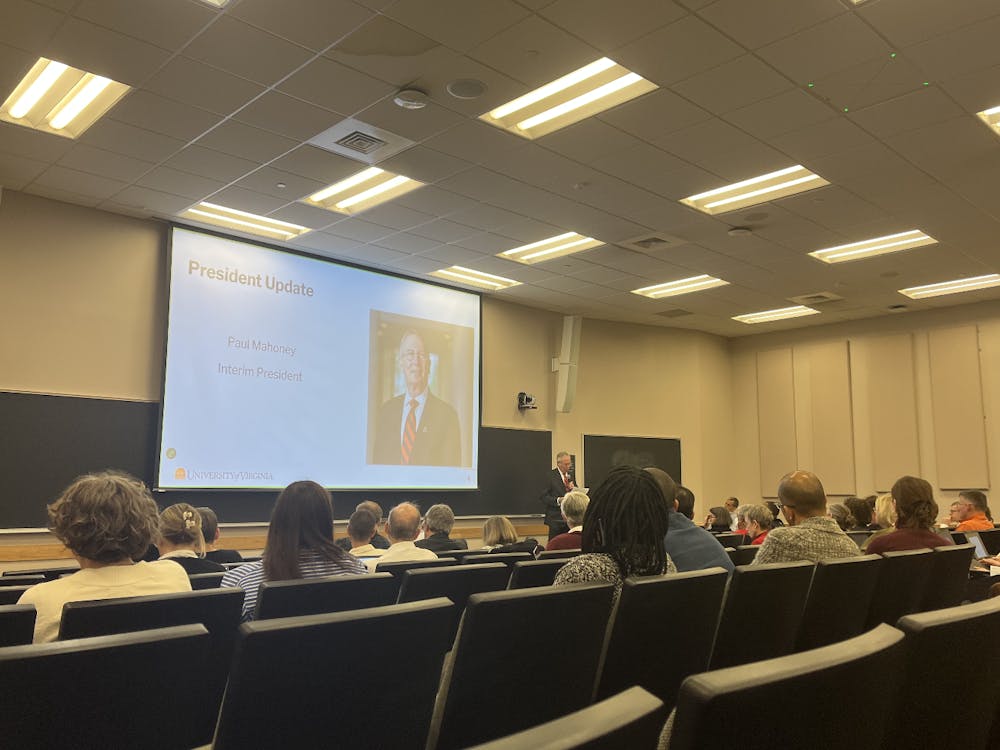Jefferson's academical village is on its way to becoming a research metropolis.
In the past 10 years, the University has funneled over $300 million into building two research parks near Central Grounds. The parks, one located on Fontaine Avenue and the other on North Fork Road near Charlottesville Airport, offer space for medical, engineering and science faculty to transform pet projects into patented products. The parks also are intended to draw more biotechnology and computer companies in from out of town, according to the University Foundation. Administrators believe that after years of lagging behind other top schools' parks, these facilities will bring research efforts up to par with Duke, Stanford and MIT.
Some wonder though, if the University has waited too long to catch up.
"We're late to the game," said Bob Burnett, associate vice president of research. "But we'd like to think it's never too late to start."
The road to research
Though liberal arts programs like English and government consistently attract top faculty at the University, in the last few years science and engineering departments haven't had as much success with recruiting. According to the University Research Park Center, this disparity in hiring grew more noticeable during the '80s and '90s when other state schools like Virginia Tech began to pour more money into their own research parks.
|
|||||||||||||||||||||||||||||
"Until the parks, we didn't have places we could point to and say 'you can do your research here,'" said David Hudson, associate vice president for research and public service at the University. "And that really helps with both retaining and recruiting technical staff."
In 1989, the Board of Visitors recognized this problem and approved the creation of the two parks. But it's taken over 12 years to create the road and water infrastructure and simply build the offices at the two sites. And North Fork still won't be completely ready for another 20 years.
As different as Jellystone and Yellowstone
Both parks take advantage of Charlottesville's vistas and are nestled in the bluish-green mountains near grounds. Similar to Stanford's research parks, which feature thousands of acres of redwood forests, developers plan to leave untouched land on 200 of the 600 acres at North Fork, as well as of Fontaine.
But the parks aren't twins. The North Fork site dwarfs Fontaine, with three million square feet and 12,000 employees, compared to only 400,000 square feet and 1,500 employees at Fontaine. And with plans for a town center that features a plaza, cafes and a hotel conference center, North Fork will offer more than research facilities.
|
"The parks serve slightly different purposes," said Tim Rose of the University Foundation. "Fontaine is more for University medical and administrative offices, and North Fork will have more small businesses started by faculty."
The University still is trying to recruit companies for both sites, although Fontaine is much closer to full occupancy than North Fork. Current tenants at Fontaine include the Virginia Neurological Institute, the Muscoskeletal Medical Building and the University Health Science Center, which features a 50-bed rehabilitation hospital.
Only six companies have jumped on board at North Fork so far. These include California-based MicroAire Surgical Instruments and Carlisle Industries, a Pennsylvania-based brake pad manufacturer.
"Raiding other states for companies isn't as effective as incubating Virginia businesses," Rose added. "But these firms will definitely offer research to members of the University community."
What's in it for me?
The parks will benefit faculty and post-doctoral students most. Associate Vice President of Research Bob Burnett estimates only five percent of the research park work force will be age 18-23.
"There might be some summer internships for undergrads, but this is mainly for upper level researchers," he said. "I don't even think graduate students will be that involved."
|
Internships also will be largely research-oriented, but as more companies sign on, administrators hope there also will be jobs in sales and marketing.
But this absence of undergraduates doesn't occur at all University research parks. Colleges such as Duke and the University of North Carolina-Chapel Hill offer 34,000 jobs in the North Carolina Research Triangle. And at Virginia Tech, four percent of the companies were started by students, according to Dr. Joe Meredith, president of the school's Corporate Research Center in Blacksburg.
"We think these parks are for all students," Meredith said.
Undergraduates aren't the only ones looking for employment opportunities. In addition to serving graduate students and faculty at the University, Burnett says the parks also can offer more work to professors' spouses.
"There are so many scientists married to each other and looking for jobs together," he said. "And this University has been late in providing for them."
Not all professors however, think research parks are the answer.
Biology Prof. John Gittleman came to the University in 1998 when his wife, Karen Holt, was appointed director of the Office of Equal Opportunity.
"You can't make sweeping generalizations about what would draw faculty here," Gittleman said. "It's such an individual choice. But what the University is doing now is paying more attention to faculty needs in the early stages, and that is definitely a plus."
And despite concerns about participation across all levels of the University, in the end few doubt the parks' mission.
"Our professors have made breakthroughs in fields from plastic surgery to pharmaceuticals to software," said Rose. "As a University, we're responsible for giving everyone a chance to learn and research and share that work with others. If we can't provide that, what exactly are we here for"






